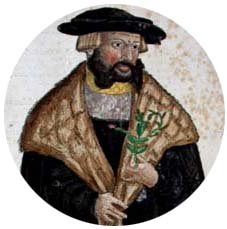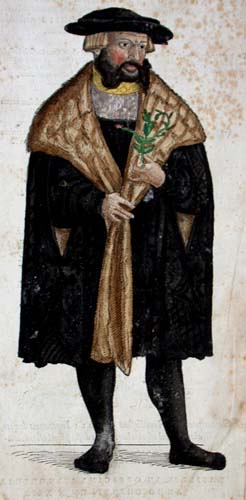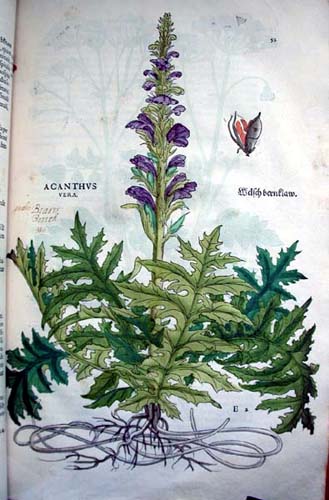| Please note that these pages are from our old (pre-2010) website; the presentation of these pages may now appear outdated and may not always comply with current accessibility guidelines. |
| Please note that these pages are from our old (pre-2010) website; the presentation of these pages may now appear outdated and may not always comply with current accessibility guidelines. |

| To celebrate the completion at the University this month of the artist Christine Borland's open air work based upon the design of a medieval physic garden, it seemed appropriate to choose one of Special Collection's grandest herbals as the October book. Leonhart Fuchs' De historia stirpium commentarii insignes (or, Notable commentaries on the history of plants) was first published in 1542. A massive, folio volume, this landmark work describes in Latin some 497 plants, and is illustrated by over 500 superb woodcuts based upon first-hand observation. |
|
|
Herbals list or describe plants and their medicinal
properties. Up to the beginning of the Sixteenth Century, botanical literature
in general -
both text and illustrations - relied heavily on the work of
Dioscorides (1 AD), a Greek physician and author of the first known
illustrated guide to medicinal plants. The first illustrated herbal to be printed
- in about 1483 in Mainz - was that of
Apuleius Platonicus, originally written in 9 AD. Its publication lead to the
production of several similar
works, including the Latin Herbarius of 1484, the German Herbarius (or
Gart de Gesundheit) of 1485 and the Hortus Sanitatis of
1491. Although these early printed herbals undoubtedly revolutionised
the dissemination of knowledge
about medicinal plants, their illustrations were crude and inaccurate,
being based upon images repeatedly copied out from
manuscripts from generation to generation, errors and all. Largely useless for
identification purposes, different plants were often depicted
by repeated use of the same woodcuts, while the descriptions of the
properties of the herbs tended to mix genuine Discoridean tradition with
local folk lore and the purely imaginary.
The Sixteenth Century, however, was the century of great herbals. The serious study of herbalism flourished as never before, resulting in the production of a plethora of works based upon field work and scientific fact. |
|
The author of the Historia Stirpium, Leonhart Fuchs (1501-1566), is known as the third of the German fathers of Botany, after Otto Brunfels and Jerome Bock. In fact, Fuchs work was greatly inspired by the Herbarum vivae icones (1530-6) of Brunfels; based upon personal observation, Brunfels work was pioneering in dramatically changing the quality of botanical illustration. Fuchs' great herbal, however, was conceived on a much larger scale than the herb books of his immediate predecessors. His aim was to reproduce each plant from life, and he stated in his dedicatory epistle that this was done for no other reason than that 'a picture expresses things more surely and fixes them more deeply in the mind than the bare words of the text'. Each illustration was therefore based upon the appearance of the living plant; furthermore, 'we have not allowed the craftsmen so to indulge their whims as to cause the drawing not to correspond accurately to the truth'. |
|
 Frontispiece: portrait of Fuchs |
Born in Bavaria at the height of the German
Renaissance and Reformation, Fuchs was a true
sixteenth century humanist. Demonstrating a precocious appetite for
learning, he matriculated at the University of Erfurt at the age of
fourteen. Having taken his BA degree, he opened a grammar school for a
year, before going on to study classics at the University of Ingolstadt.
He then turned his
attention to medicine and took a doctor's degree - his background in
classics and profound knowledge of Greek allowing him to read old medical texts with ease.
Thus, while much of sixteenth century medicine was still subordinated to astrology
and mythology, Fuchs sought to restore the logical and realistic practises
of Greek medicine.
He began practising as a physician in Munich in 1524, but returned to Ingolstadt in 1526 as a professor of medicine. In 1528 he was summoned to Anbach to be the personal physician of Prince Georg, margrave of Brandenburg, who hoped to establish a Protestant University at Anbach. Although these plans for a university came to nothing, it was during this period that Fuchs became established as a writer. He gained his initial fame by finding a cure for the English sweating sickness, and was soon in demand as both a practitioner and teacher across Europe. In 1535 he was appointed to a chair at Tübingen, the post he held for the rest of his life. While he continued to publish books at a prolific rate, teaching was Fuchs' priority: he brought many innovations to the curriculum, including - perhaps not surprisingly - introducing botanical field excursions to the training schedule for physicians. |
|
The Historia is undoubtedly Fuchs' greatest work, and is without equal among the herb books of that era. A labour of love some thirty one years in the making, Fuchs' lively enthusiasm for his subject is obvious. As he himself stated: 'there is nothing in this life pleasanter and more delightful than to wander over woods, mountains, plains, garlanded and adorned with flowerlets and plants of various sorts, and most elegant to boot, and to gaze intently on them. But it increases that pleasure and delight not a little, if there be added an acquaintance with the virtues and powers of these same plants' (quoted by Arber). In the preface to his work, Fuchs explains that he is writing for the benefit of his fellow physicians, stating indignantly that it was difficult to find one physician out of a hundred who had accurate knowledge of even a few plants. Primarily a physician rather than a botanist, he emphasised the pharmacological aspects of plants, although the characteristics of the plants, their habits, habitats and forms are also outlined. Amongst the remedial properties described for the thistle depicted on the right, for example, Fuchs notes that 'a drachma in weight' of the root taken in wine, is of benefit against the contagion of pestilence. Furthermore, the same 'steeped in vinegar, is helpful against scabies, impetigo, and all blemishes of the skin difficult to cure, if they are washed with the decoction. The same also helps toothache'. |
|
|
|
|
Fuchs aimed to include all the plants known to him with recognised medicinal properties. Arranged alphabetically by the Greek names of the plants, no attempt was made at a natural system of classification: that had to wait until the work of John Ray and Carl Linnaeus. Although the descriptions help to distinguish one species from another, Fuchs relied on the illustrations to be used as the main means for identifying the plants; consequently, his accounts of the plants are brief and even sometimes inaccurate. While a number are original, many of them are largely derived from traditional medical texts, unashamedly bringing together 'the best work of the ancients'. |
|
|
| Fuchs was interested in describing the new and exotic as well as those plants that were purely medicinal. The chilli pepper was one of five New World plants, all unknown in Europe until the early years of the Sixteenth Century, described for the first time in the Historia. Fuchs did not actually know the geographic origin of the plant, and simply assigned it a name from Pliny that seemed appropriate: he called it the 'siliquastrum' (big pod) signifying a large, elongated fruit - Pliny's plant of this name, however, was not the same. |
|
|
|
|
Although little attention was generally paid to the
smaller details of flowers, the overall accuracy of the
illustrations is remarkable considering that the artists
were working at a time before the invention of
the microscope. Unusually, full recognition was in fact given to the three artists involved
in producing the work. The plants were drawn from nature by
Albrecht Meyer, transferred to woodblocks by Heinrich
Füllmaurer, and cut into wood by Veit Rudolf Speckle,
'by far the best engraver in Strasbourg'. Such was their
importance that their group portrait is included at the end
of the book.
The Historia illustrates over 100 species for the first time, many of the specimens probably coming from Fuchs' garden in Tübingen; over a thirty-five year period, he grew many of the plants featured in his herbal, including the exotics. |
|
|
| The Historia originally appeared in both coloured and uncoloured states when first published. The thinness of the lines in the figures was intentional because Fuchs expected the illustrations to be coloured and did not want the natural form of plants to be obliterated by shading. Although Meyer has identified some copies of the work issued as coloured, many of the coloured copies were 'completed' after publication, as is probably the case in our copy. The vivid watercolours here, however, for the most part seem to follow closely the original colour scheme. |
|
|
|
|
|
|
The popularity of herbalism is further demonstrated by the number of books on the topic published and repeatedly reprinted during the period. Fuchs' edition of the Historia was abridged into a German language folio edition a year after the original; this edition was intended primarily for the German public unable to read Latin. These folio editions were unwieldy to use, however, and the work was soon published in smaller, more convenient formats: these pocket edition could then actually be taken into the field. All in all, during Fuchs' lifetime alone, the Historia and its various abridgements went through thirty-nine imprints in Latin, German, French, Spanish and Dutch. The woodblocks, meanwhile, were re-used and plagiarised for a further three hundred years. Thus, the influence of the Historia on herbal literature was of enormous significance. Although not without its critics, its original publication in 1542 brought Fuchs immediate and largely favourable acclaim in Europe. In fact, Fuchs intended to write an expanded text of the work, but although he laboured on this for the last twenty-four years of his life, it was never published; the manuscript of this work (dubbed the 'Vienna codex') is in the Austrian National Library. The importance of the Historia has been highlighted in recent years by the publication of a facsimile (with detailed interpretative commentary) by Stanford University press, edited by Frederick G. Meyer who describes the volume as a 'folio of awesome splendor'. |
 Page 52: Acanthus spinosus (Prickly bear's-breech) |
Other items of interest |
|
Return to main Special Collections Exhibition Page Julie Gardham October 2002
|